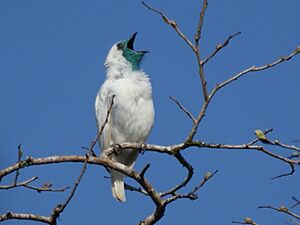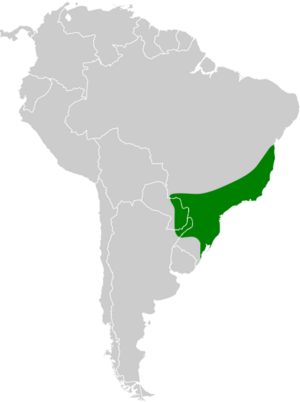Bare-throated bellbird facts for kids
Quick facts for kids Bare-throated bellbird |
|
|---|---|
 |
|
| In Paraná, Brazil. | |
| Conservation status | |
| Scientific classification | |
| Genus: |
Procnias
|
| Species: |
nudicollis
|
 |
|
The bare-throated bellbird (Procnias nudicollis) is a unique bird found in the moist forests of Argentina, Brazil, and Paraguay. It belongs to the Cotingidae family. This bird is famous for its incredibly loud call, which sounds like a hammer hitting an anvil!
Male bare-throated bellbirds have striking white feathers. They also have bare, bluish-black skin around their eyes, beak, and throat. Female bellbirds are not as colorful. They have olive-brown feathers on their backs and streaked yellow feathers underneath. This bird is about 27 centimeters (11 inches) long.
Like other bellbirds, P. nudicollis has a short beak with a very wide opening, called a gape. This wide mouth helps them eat large fruits.
Template:TOC limit=3
Voice
The male bare-throated bellbird has one of the loudest calls of any bird on Earth. It makes a sharp, metallic sound, just like a hammer hitting an anvil or a ringing bell.
To make this amazing sound, the bird takes a deep, quick breath. This increases the air pressure in special air sacs around its syrinx (its voice box). Young male bellbirds need a long time to learn this complex call. One young male practiced for over 10 months and still couldn't get it perfect!
Where They Live
The bare-throated bellbird lives in Brazil, Paraguay, and Argentina. It is common in Brazil and Paraguay. However, it is quite rare in Argentina. In 2017, experts thought fewer than 250 adult birds lived in Argentina.
Unlike many other cotingid birds, bare-throated bellbirds move seasonally. They travel to different forest heights in Paraguay and eastern Brazil. These movements depend on where fruits are growing and the age of the birds. Some evidence suggests they also migrate in southeastern Brazil and nearby Paraguay. They might only visit Argentina during these migrations.
Their natural homes are moist lowland forests and moist montane forests (forests on mountains). They prefer primary forests, which are old, untouched forests. But they can also live in secondary forests (forests that have grown back) if there are fruit trees. They have even been seen in old rubber plantations.
Sometimes, these birds are spotted in unusual places. In 2007, a young male was seen looking for food at the Federal University of Rio de Janeiro. This is an urban area on an artificial island near a busy bay. Another bird was spotted in 2005 at Ibirapuera Park in São Paulo.
Behaviour
Bare-throated bellbirds, like other cotingids, spend little time looking for food. This is because they eat mostly fruit, and fruit doesn't move! So, they spend a lot of their time preening (cleaning their feathers) and resting. They also sing a lot during their breeding season.
Diet
As a fruit-eating species, P. nudicollis helps spread seeds for the plants it eats. This is very important for the Atlantic rainforest ecosystem. For example, they help spread the seeds of the Euterpe edulis palm tree.
They eat fruits from many different plant families. Their wide mouths allow them to swallow whole fruits. Then, they can spit out the large seeds later.
While adult bellbirds mostly eat fruit, snails have been found in the stomach of one bellbird specimen. Scientists think snails might be a source of calcium for female birds when they are laying eggs. Other birds in the Cotingidae family, like the scaled fruiteater, also eat snails for this reason.
Mating
The male P. nudicollis uses its loud call to attract a mate. It usually sings from a high branch. Their breeding season lasts from September to February.
Conservation Status
The bare-throated bellbird is listed as "Near Endangered" in Brazil. This means it is close to being endangered. It has been found in several protected areas there, such as Intervales State Park and Pico do Marumbi State Park. Efforts to replant forests in places like the Reserva Ecologica Michelin might help expand their territory.
In Argentina and Paraguay, the bare-throated bellbird is listed as "Endangered." It has been found in protected areas like the Reserva Natural del Bosque Mbaracayú in Paraguay. This reserve even uses the bird in campaigns to teach high school students about nature. It has also been seen in Argentinian protected areas like Iguazú National Park.
Habitat Loss
The bare-throated bellbird is threatened because its home is disappearing. Forests are being cut down for farms and other uses. Only about 10% of its original forest home remains in six Brazilian coastal states. Other threats include cities growing, new industries, and building roads.
Poaching
The bare-throated bellbird is also threatened by heavy poaching. Poaching means illegally catching animals. These birds are popular as cagebirds (pet birds) in Brazil.
Most illegal trapping happens in southern Brazil, especially in Bahia, São Paulo, and Santa Catarina. It also happens in Paraguay, with birds often sold in its capital city, Asunción.


